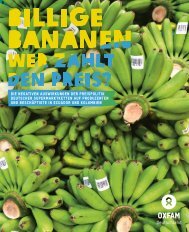228776e
228776e
228776e
Create successful ePaper yourself
Turn your PDF publications into a flip-book with our unique Google optimized e-Paper software.
Narrative structure and point of view<br />
All texts relating to the Holocaust have been written by the textbook authors, while the<br />
proportion of authors’ texts in the books as a whole is 50 to 80 percent. All adhere to<br />
chronological narratives except T5, which arranges information thematically. The texts are<br />
all descriptive and written in the third person singular, and four use the passive voice,<br />
whereas T5 also uses the active voice. T4 is the only book to provide multiple perspectives<br />
of victims, perpetrators and Allies. T1 and T2 contain progressive narratives by ending with<br />
the topic of post-war peace agreements and the role of the United Nations. ‘Germany’<br />
and ‘Germans’ are named as collective subjects of history in T1, T2, T3 and T4. T3 quotes<br />
the ‘Jewish problem’ without using inverted commas, and therefore reproduces Nazi<br />
terminology uncritically.<br />
Didactic approach<br />
Pupils are offered few opportunities to interpret the event because texts are almost entirely<br />
confined to those written by textbook authors. These texts are conceptualized largely in<br />
terms of war crimes (T1, T2 and T3), human rights and human morality (T3, T4 and T5), and<br />
crimes against humanity (T4). Only T4 contains exercises geared specifically towards the<br />
Holocaust, in a rubric entitled ‘Holocaust, Banality of Evil’, in the form of multiple choice<br />
questions and text analysis.<br />
National idiosyncrasies<br />
Brazil is mentioned twice. T3 mentions the interdependence of Brazilian and European<br />
history during the Second World War, and T4 mentions, in passing, German and Jewish<br />
refugees from the war period in Brazil.<br />
Bibliography<br />
T1: Campos Azevedo, G. and Seriacopi, R. 2011. História. São Paulo, Ática. (history, age 14-17 years, in Portuguese)<br />
T2: Vicentino, C. and Dorigo, G. 2005. História para o Ensino Médio [history for the Secondary School Level]. São<br />
Paulo, Scipione. (history, age 14-18 years, in Portuguese)<br />
T3: de Campos, F. and Garcia Miranda, R. 2005. A escrita da história: ensino médio [The Writing of History, Secondary<br />
School Level]. São Paulo, Escala Educacional. (history, age 14-18 years, in Portuguese)<br />
T4: Vainfas, R., de Castro-Faria, S., Ferreira, J. and dos Santos, G. 2010. História. São Paulo, Saraiva. (history,<br />
age 16-17 years, in Portuguese)<br />
T5: Schmidt, M. 2000. Nova história crítica. São Paulo, Nova Geração. (history, age 14-17 years, in Portuguese)<br />
89




